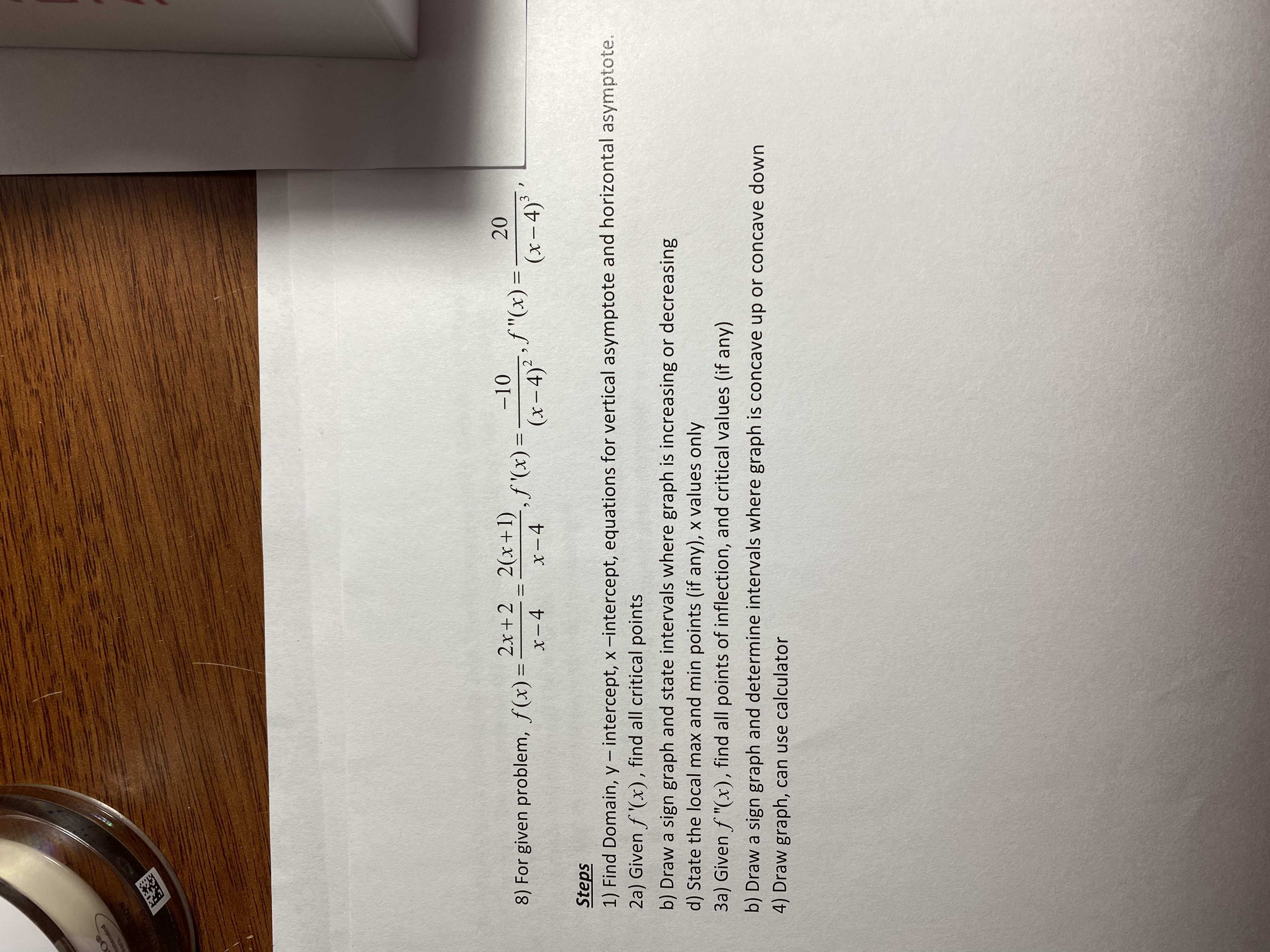
Calculus: Early Transcendentals
8th Edition
ISBN: 9781285741550
Author: James Stewart
Publisher: Cengage Learning
expand_more
expand_more
format_list_bulleted
Concept explainers
Question
For given problem,
2a.) given f'(x) find all critical points
2b.) draw a sign graph and state intervals where graph is increasing or decreasing
2d.) state the local max and min points (if any), x values only

Expert Solution
This question has been solved!
Explore an expertly crafted, step-by-step solution for a thorough understanding of key concepts.
Step by stepSolved in 2 steps with 2 images

Knowledge Booster
Learn more about
Need a deep-dive on the concept behind this application? Look no further. Learn more about this topic, calculus and related others by exploring similar questions and additional content below.Similar questions
- A.) What are the relative minimum and relative maximum values over the interval [-3,2] for the function shown in the graph? B.) At what intervals is the entire function increasing? C.) At what intervals is the entire function decreasing?arrow_forwardIf (x+1) replaces x , and (y+2) replaces y , describe the effect on the graph of y=f(x) A) Stays in the same postion B) moves one unit left and two units down C) moves one unit left and two units up D) moves one unit right and two units uparrow_forwardLl.30.arrow_forward
- 4) The cost of making x items is C(x)=15+2x. The cost p per item and the number made x are related by the equation p+x=25. Profit is then represented by px-C(x) [revenue minus cost]. a) Find profit as a function of x b) Find x that makes profit as large as possible c) Find p that makes profit maximum.arrow_forward2. If f(2) = e*, describe the images under f(z) of horizontal and vertical lines, i.e. what are the sets f(a + it) and f(t + ib), where a and b are constants and t runs through all real numbers?arrow_forward14. Given the following graph of the function y= f(x), construct the graph of the function y= f"(x). (0,2), (1,3), (2,5), (3,9), (-1,1.5) -8 7- -5 -3 -9 -8 -7 -6 -5 -4 -3 -2 2 6 -2 Solution: https://youtu.be/plmnlQ2nb3g PRESSarrow_forward
arrow_back_ios
arrow_forward_ios
Recommended textbooks for you
 Calculus: Early TranscendentalsCalculusISBN:9781285741550Author:James StewartPublisher:Cengage Learning
Calculus: Early TranscendentalsCalculusISBN:9781285741550Author:James StewartPublisher:Cengage Learning Thomas' Calculus (14th Edition)CalculusISBN:9780134438986Author:Joel R. Hass, Christopher E. Heil, Maurice D. WeirPublisher:PEARSON
Thomas' Calculus (14th Edition)CalculusISBN:9780134438986Author:Joel R. Hass, Christopher E. Heil, Maurice D. WeirPublisher:PEARSON Calculus: Early Transcendentals (3rd Edition)CalculusISBN:9780134763644Author:William L. Briggs, Lyle Cochran, Bernard Gillett, Eric SchulzPublisher:PEARSON
Calculus: Early Transcendentals (3rd Edition)CalculusISBN:9780134763644Author:William L. Briggs, Lyle Cochran, Bernard Gillett, Eric SchulzPublisher:PEARSON Calculus: Early TranscendentalsCalculusISBN:9781319050740Author:Jon Rogawski, Colin Adams, Robert FranzosaPublisher:W. H. Freeman
Calculus: Early TranscendentalsCalculusISBN:9781319050740Author:Jon Rogawski, Colin Adams, Robert FranzosaPublisher:W. H. Freeman
 Calculus: Early Transcendental FunctionsCalculusISBN:9781337552516Author:Ron Larson, Bruce H. EdwardsPublisher:Cengage Learning
Calculus: Early Transcendental FunctionsCalculusISBN:9781337552516Author:Ron Larson, Bruce H. EdwardsPublisher:Cengage Learning

Calculus: Early Transcendentals
Calculus
ISBN:9781285741550
Author:James Stewart
Publisher:Cengage Learning

Thomas' Calculus (14th Edition)
Calculus
ISBN:9780134438986
Author:Joel R. Hass, Christopher E. Heil, Maurice D. Weir
Publisher:PEARSON

Calculus: Early Transcendentals (3rd Edition)
Calculus
ISBN:9780134763644
Author:William L. Briggs, Lyle Cochran, Bernard Gillett, Eric Schulz
Publisher:PEARSON

Calculus: Early Transcendentals
Calculus
ISBN:9781319050740
Author:Jon Rogawski, Colin Adams, Robert Franzosa
Publisher:W. H. Freeman


Calculus: Early Transcendental Functions
Calculus
ISBN:9781337552516
Author:Ron Larson, Bruce H. Edwards
Publisher:Cengage Learning